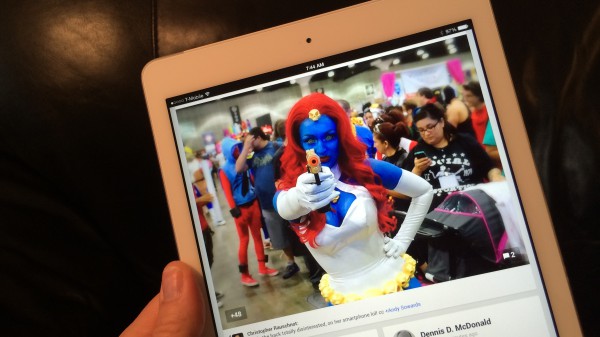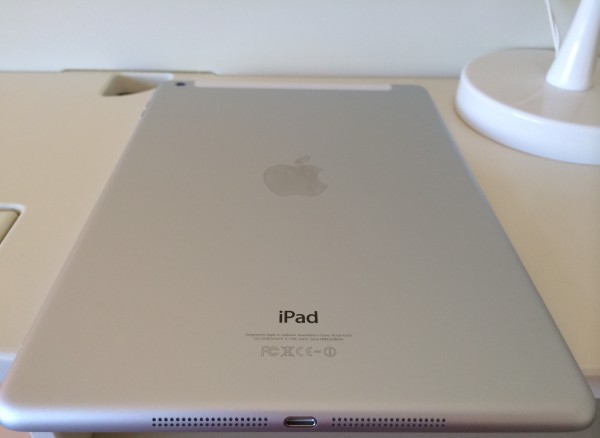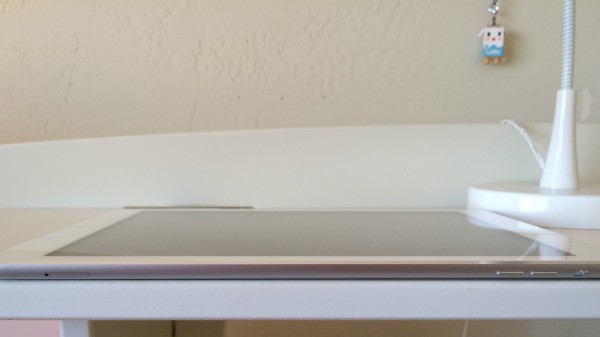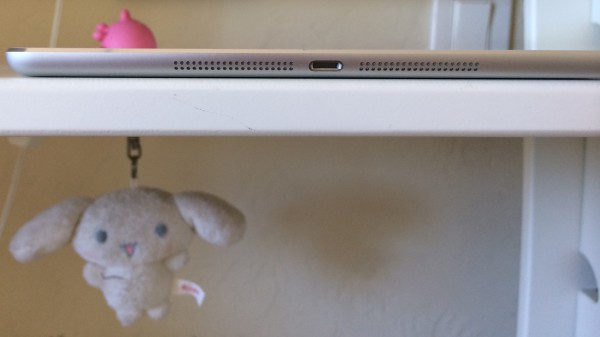Apple iPad Air first-impressions review

Sometimes there is revolution in evolution. That's my surprising reaction to iPad Air, which Apple started selling on November 1. This is simply the best tablet I have ever used. Period. The fruit-logo company wisely chose to resist reinventing the wheel and build a vehicle around four instead.
For people who complain -- and there are many -- that Apple's newest 9.7-inch tab shows waning innovation, let me correct the record. You are oh-so wrong. iPad Air is an amazingly refined piece of art -- like a sculpture chiseled to perfection. iPad 3 and 4 are unpolished bricks by comparison. More importantly, anyone looking for a tablet to largely, or completely, replace a Windows PC or Mac, Air is it.
Apple's newest full-size tab is so remarkable, the two previous models look bad. For critics searching for lacking innovation, there it is. Rather than advance the motif, the company reversed by putting in a fat, heavy battery to support the previous generations' higher-resolution displays. The new iPad knocks almost 200 grams off iPad 3's or 4's weight and reduces width by 16 millimeters and thickness by 1.9 millimeters.
By contrast, iPad Air is heavy where it counts -- performance from the 64-bit A7 chip, iOS 7's smooth operation and the device's long battery life -- and light everywhere else. With respect to thinness, lightness and innovation, only Sony Xperia Tablet Z comes close.
Air Smells Sweet
On launch day, I queued up with 30 other people before my local Apple Store opened to buy the tablet for my nearly 92 year-old father-in-law. He is moving from the original MacBook Air released five years ago to iPad Air. While buying the tab for him, I snatched one, too. WiFi for him, LTE for me.
For months he asked about possibly replacing the laptop with a tablet. The time is right. By branding and marketing material, Apple positions iPad Air as a PC alternative, acknowledging what analysts have said for a year (and I for three) -- tablets cannibalize computer sales.
"Air" branding clearly is deliberate, tying to the company's lightest laptop. There is the 64-bit chip, which further closes the gap with OS X. Finally, Apple now provides the iOS versions of desktop productivity apps Keynote, Numbers and Pages free with Air (and iPad mini Retina Display), too. By that reckoning, the cheapest Mac you now can buy is $499, not $999 MacBook Air. Something else: I find iOS 7's flat design to be superior to OS X's quasi-3D. The desktop OS motif is more cluttered, visually distracting and more eye-exhausting to use, by comparison.
Some people complain about iOS 7, perhaps because they're too attached to the past motif. But the usability is tremendously greater, and the UI is better-suited to touch than its predecessors.
iPad Air feels fast and resoundingly responds. My father-in-law marvels at webpages that open nearly instantly compared to seconds and seconds and seconds on his aged Mac laptop. That's with the benefit of a 64GB SSD I installed two years ago.

How Air Compares
Since so many of our readers obsess about specs, let's dispatch with them before getting to my nuts-and-bolts first impressions and compare to two other worthy tablets.
Apple iPad Air: 9.7-inch display, 2048 x 1536 resolution, 264 pixels per inch; 64-bit A7 chip with M7 motion coprocessor; 1GB of RAM; 16GB, 32GB, 64GB or 128GB storage (depending on model); 5-megapizel rear- and 1.2MP front-facing cameras; WiFi N; LTE (some models); Bluetooth; 10-hour battery; iOS 7. Measures 240 x 169.5 x 7.5 mm and weighs 469 grams (WiFi) or 478 grams (LTE). Prices range from $499 (16GB WiFi) to $929 (128GB LTE).
Sony Xperia Tablet Z: 10-inch display, 1920 x 1200 resolution, 224 ppi; 1.5GHz Qualcomm Snapdragon S4 Pro APQ8064 Cortex-A9 processor; 2GB of RAM; 16GB or 32GB storage (depending on model); 8MP rear- and 2MP front-facing cameras; NFC; WiFi N; LTE (some models); Bluetooth; micro-SD card slot; 10-hour battery; Android 4.2.2. Measures 266 x172 x 6.9 mm and weighs 495 grams. 16GB: $499. 32GB: $599. 16GB LTE: $629.
Google Nexus 10: 10.055-inch display, 2560 x 1600 resolution, 300 ppi; 1.7GHz Exynos 5 (Cortex A-15) dual-core processor; Mali T604 graphics chip; 2GB of RAM; 16GB or 32GB storage (depending on model); 5MP back- and 1.9MP front-facing cameras; NFC; WiFi N; Bluetooth; 10-hour battery; Android 4.3. Measures 263.9 x 177.6 x 8.9 mm and weighs 630 grams. 16GB: $399; 32GB: $499.
Nexus 10 is the most-affordable of the three tabs and packs the highest pixel density. Xperia Tablet Z is water- and dust-resistant and offers expandable storage. iPad Air's merits aren't as obvious. They're a culmination of finely-tuned attributes.
Lighter Than Air
The new iPad's screen is supremely bright and crisp, even if by the specs inferior to Nexus 10 in pixel density and absolute resolution. Some of the iOS apps displease by how odd-sized some fonts render. Many are just too large or deliver too many mixed-sizes; displeasing.
But the overall app experience outclasses Android, particularly ebooks, magazines, newspapers and webpages. As I expressed about the original iPad three years ago, the reading experience is enormously immersive. That hasn't changed, nor has it improved on Android. There are several reasons for this difference. Platform and app designs rank highly. Another is subtle and relates directly to screen size and tablet shape.

iPad Air's dimensions and weight are perfect for one-handed use. No tablet in the 9-inch+ category compares. Sony Xperia Tablet Z is close, mainly because of similar lightness. The Sony is 23 grams heavier and about a millimeter thinner, but iPad Air's dimensions are better.
Most Android slates -- Tablet Z, among them -- are taller in portrait mode, while iPads are generally squatter. Air's appearance is more pronouncedly squat because the screen stretches closer to the rim -- like the mini. Android apologists scoff at iPad's screen dimensions, because they aren't 16:9. But such orientation, while good for landscape mode makes tabs top heavy in portrait orientation. Apple's tablet is much better for reading. Yeah, some of us actually do this rather than primarily watch movies or play games -- activities more-than-enjoyable on iPad Air. But not just reading, truly immersive -- as in content absorption.
Apple's tablet feels good in the hand. Solid, and the screen doesn't show fingerprints as much as, say, Google Nexus 10. This is the first 9-inch+ tab I can comfortably and accurately type on with my thumbs in portrait orientation. Again, Xperia Z is close. The Sony tablet is easer one way because it's narrower than longer in portrait. However, iPad Air has better balance.
Balance is everything in gadgets, something photographers have known for decades. Moto X has great balance. By comparison, Nexus 5 does not. iPad Air is superbly balanced, something you really feel shifting it in your hands. The last two models were heavy and unbalanced for any long-time use, particularly for reading in portrait mode. Apple committed customer injustice by chucking to market iPad 3 and 4 bricks. Air is iPad 2's true successor.
Breath of Fresh Air
For years I have toyed with the idea of replacing laptop with tablet. But none has offered the right combination of performance, usability and productivity apps. iPad Air may be the one, and I strongly contemplate putting aside Chromebook Pixel for the Apple tab.
iPad Air is a tablet that can replace a laptop -- hey, my elderly father-in-law is doing just that. Granted, his needs are more limited. Hell, if I can be satisfied with Chromebook, why not Air?

Apple pushes 64-bit architecture across its product line. That's unification underway the Android camp shouldn't underestimate. There's more to tablet computing benefits than how many cores the main processor packs.
My positive reaction isn't about one thing. It's a culmination. iPad Air is refreshing and the user experience is exceptional. Under Steve Jobs' leadership, Apple wowed with category-changing products that led to well-deserved reputation for innovation. Last month, many Apple critics and fans reacted negatively to another seemingly-the-same iOS tab. Don't be fooled by them. Refinement is innovation, too.
iPad Air is a fine wine. You have to crack the cork, take in the fragrance and savor the taste to appreciate its vintage.
Photo Credits: Joe Wilcox
